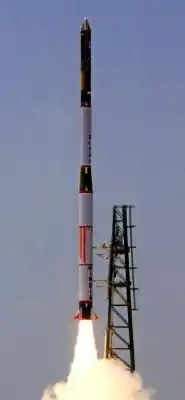Satellite Launch Vehicle
The Satellite Launch Vehicle or SLV was a small-lift launch vehicle project started in the early 1970s by the Indian Space Research Organisation to develop the technology needed to launch satellites. SLV was intended to reach a height of 400 kilometres (250 mi) and carry a payload of 40 kg (88 lb).[2] The first experimental flight of SLV-3, in August 1979, was a failure.[3] The first successful launch took place on 18 July, 1980.
 Satellite Launch Vehicle | |
| Function | Small-lift launch vehicle |
|---|---|
| Manufacturer | ISRO |
| Country of origin | India |
| Size | |
| Height | 22 m (72 ft) |
| Diameter | 1 m (3.3 ft) |
| Mass | 17,000 kg (37,000 lb) |
| Capacity | |
| Payload to LEO | |
| Altitude | 400 km (250 mi) |
| Mass | 40 kg (88 lb) |
| Associated rockets | |
| Derivatives | ASLV, PSLV |
| Launch history | |
| Status | Retired |
| Launch sites | Sriharikota |
| Total launches | 4 |
| Success(es) | 2 |
| Failure(s) | 1 |
| Partial failure(s) | 1 |
| First flight | 10 August 1979 |
| Last flight | 17 April 1983 |
| Notable payloads | Rohini |
| First stage | |
| Propellant mass | 8.6 t (19,000 lb) |
| Engines | 1 solid |
| Thrust | 450 kN (100,000 lbf) |
| Specific impulse | 253 seconds (2.48 km/s) |
| Burn time | 49 seconds |
| Fuel | PBAN (Polybutadine Acrylo Nitrate) Solid[1] |
| Second stage | |
| Propellant mass | 3 tonnes |
| Engines | 1 solid |
| Thrust | 20 tonnes |
| Specific impulse | 267 sec |
| Burn time | 40 seconds |
| Fuel | PBAN (Polybutadine Acrylo Nitrate) Solid |
| Third stage | |
| Propellant mass | 1 tonnes |
| Engines | 1 solid |
| Thrust | 6.3 tonnes |
| Specific impulse | 277 sec |
| Burn time | 45 seconds |
| Fuel | High energy propellant (HEF 20) Solid |
| Fourth stage | |
| Propellant mass | 262 kg |
| Engines | 1 solid |
| Thrust | 2.4 tonnes |
| Specific impulse | 283 sec |
| Burn time | 33 seconds |
| Fuel | High energy propellant (HEF 20) Solid |
It was a four-stage rocket with all solid-propellant motors.[3]
The first launch of the SLV took place in Sriharikota on 10 August 1979. The fourth and final launch of the SLV took place on 17 April 1983.
It has taken approximately seven years to realise the vehicle from start. The solid motor case for first and second stage are fabricated from 15 CDV6 steel sheets and third and fourth stages from fibre reinforced plastic.[1]
Launch statistics
- Failure
- Partial failure
- Success
Launch history
All four SLV launches occurred from the SLV Launch Pad at the Sriharikota High Altitude Range. The first two launches were experimental (E) and the next 2 were designated as developmental (D) as this was the first launch vehicle being developed by India not intended for a long service life.[4]
| Flight № | Date / time (UTC) | Rocket, Configuration |
Launch site | Payload | Payload mass | Orbit | User | Launch outcome |
|---|---|---|---|---|---|---|---|---|
| E1 | 10 August 1979 | Satellite Launch Vehicle | SLV Launch Pad | Rohini Technology Payload[5] | 35 kg | Low Earth | ISRO | Failure |
| Faulty valve caused vehicle to crash into the Bay of Bengal 317 seconds after launch.[4] | ||||||||
| E2 | 18 July 1980 | Satellite Launch Vehicle | SLV Launch Pad | Rohini RS-1 | 35 kg | Low Earth | ISRO | Success [4] |
| It was the first satellite successfully launched by the indigenous launch vehicle SLV. It provided data on the fourth stage of SLV. | ||||||||
| D1 | 31 May 1981 | Satellite Launch Vehicle | SLV Launch Pad | Rohini RS-D1 | 38 kg | Low Earth | ISRO | Partial failure |
| Orbit too low. Decayed after 9 days[4] | ||||||||
| D2 | 17 April 1983 | Satellite Launch Vehicle | SLV Launch Pad | Rohini RS-D2 | 41.5 kg | Low Earth | ISRO | Success[4] |
| Earth Observation satellite | ||||||||
See also
References
- "First Successful Launch of SLV-3 - Silver Jubilee" (PDF). ISRO.
- "Launch Vehicles". Department of Space, Government of India. Archived from the original on 1 February 2014. Retrieved 19 January 2014.
- "SLV". isro.gov.in. Retrieved 5 September 2015.
- TS Subramanian. "Silver jubilee of the first successful SLV-3". Frontiline. Archived from the original on 8 February 2018. Retrieved 8 February 2018.
- "Rohini Technology Payload". Retrieved 28 December 2014.
